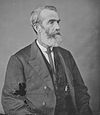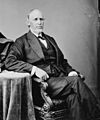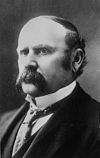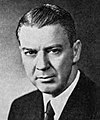Tennessee's 4th congressional district
| Tennessee's 4th congressional district | |||
|---|---|---|---|
Interactive map of district boundaries since January 3, 2023 | |||
| Representative |
| ||
| Distribution |
| ||
| Population (2022) | 796,991[1] | ||
| Median household income | $65,227[1] | ||
| Ethnicity |
| ||
| Cook PVI | R+22[2] | ||
The 4th congressional district of Tennessee is a congressional district in southern Tennessee. It has been represented by Republican Scott DesJarlais since January 2011.
Most of the district is rural, but many residents live in the suburbs of Chattanooga and Nashville. The area is very hilly, and has many well-known geographical features related to its location on the Cumberland Plateau.
This part of Tennessee has several well-recognized
The region encompasses many of Tennessee's higher education facilities, such as Middle Tennessee State University, Sewanee: The University of the South, and Bryan College.
Current boundaries
The district lies mostly in the southern part of Middle Tennessee, but stretches into East Tennessee. It is currently composed of the following counties: Bedford, Bledsoe,Coffee, Franklin, Giles, Grundy, Lawrence, Lincoln, Marion, Meigs, Moore, Rhea, Rutherford, Sequatchie, and the vast majority of Warren.
Recent election results in statewide races
Results under old lines (2013-2023)
| Year | Office | Result |
|---|---|---|
| 2000 | President | George W. Bush (R) 50% – Al Gore 49% (D) |
| 2004 | President | George W. Bush (R) 58% – John Kerry 41% (D) |
| 2008 | President | John McCain (R) 62.6% – Barack Obama 35.8% (D) |
| 2012 | President | Mitt Romney (R) 65.3% – Barack Obama 33% (D) |
| 2016 | President | Donald Trump (R) 68.6% – Hillary Clinton 27.4% (D) |
| 2020 | President | Donald Trump (R) 67.5% - Joe Biden 30.7% (D) |
History
Throughout the 20th century, the 4th district took many different forms, but in most cases encompassed most of the rural area between Nashville and Knoxville. It has often been the state's largest district in terms of area, and one of the largest east of the Mississippi River, because of low population density and the district's rural character.
For almost thirty years (1947-1977), this area of Tennessee was represented in Congress by
The new district incorporated pieces of heavily
In 1982, Democrat
Cooper gave up his seat to run for the U.S. Senate in 1994, but lost to Fred Thompson. Republican Van Hilleary won the seat as part of the massive Republican wave of that year. Hilleary was reelected three times without much difficulty, handily winning a second term even as Bill Clinton carried the district due to Gore's presence as his running mate; Gore represented much of the western portion of the district for his first three terms in the House.
In 2002, Hilleary retired to mount an ultimately unsuccessful bid to become Governor of Tennessee, and was replaced by Democratic state senator Lincoln Davis. Davis held the seat for eight years. In 2010, Davis was challenged by Republican doctor Scott DesJarlais from South Pittsburg, who rode to victory on the Tea Party wave of 2010 despite Davis raising more money.[7] This marked the first time that an incumbent had been defeated in the district since the reformation of the district in 1982. Indeed, DesJarlais became the first challenger to defeat an incumbent Tennessee congressman in a general election since 1974. Following the 2010 census, the 4th was made slightly more compact. The district lost its northern portion, including its territory near the Tri-Cities and Knoxville. On the other hand, it gained all of Rutherford County, home of Murfreesboro, and northern Bradley County.
List of members representing the district
| Name | Party | Years | Cong ress |
Electoral history | District location |
|---|---|---|---|---|---|
| District established March 4, 1813 | |||||
| John H. Bowen (Gallatin) |
Democratic-Republican
|
March 4, 1813 – March 3, 1815 |
13th | Elected in 1813. Retired. |
1813–1823 [data missing] |
| Bennett H. Henderson (Hendersonville) |
Democratic-Republican
|
March 4, 1815 – March 3, 1817 |
14th | Elected in 1815. Retired. | |
| Samuel E. Hogg (Lebanon) |
Democratic-Republican
|
March 4, 1817 – March 3, 1819 |
15th | Elected in 1817. Retired. | |
| Robert Allen (Carthage) |
Democratic-Republican
|
March 4, 1819 – March 3, 1823 |
16th 17th |
Elected in 1819. Re-elected in 1821. Redistricted to the 5th district. | |
| Jacob C. Isacks (Winchester) |
Democratic-Republican (Jackson)
|
March 4, 1823 – March 3, 1825 |
18th 19th 20th 21st 22nd |
Re-elected in 1831. and lost re-election.
Redistricted to the 5th district |
1823–1833 [data missing] |
Jacksonian
|
March 4, 1825 – March 3, 1833 | ||||
 James I. Standifer (Mount Airy) |
Jacksonian
|
March 4, 1833 – March 3, 1835 |
23rd 24th 25th |
Redistricted from the Re-elected in 1837 .Died. |
1833–1843 [data missing] |
Anti-Jacksonian
|
March 4, 1835 – March 3, 1837 | ||||
| Whig | March 4, 1837 – August 20, 1837 | ||||
| Vacant | August 20, 1837 – September 14, 1837 |
25th | |||
| William Stone (Delphi) |
Whig
|
September 14, 1837 – March 3, 1839 |
Elected September 14, 1837, to finish Standifer's term and seated October 6, 1837.Lost re-election. | ||
| Julius W. Blackwell (Athens) |
Democratic
|
March 4, 1839 – March 3, 1841 |
26th | Elected in 1839 .Lost re-election. | |
| Thomas J. Campbell (Athens) |
Whig
|
March 4, 1841 – March 3, 1843 |
27th | Elected in 1841. and lost re-election.
Redistricted to the 3rd district | |
| Alvan Cullom (Livingston) |
Democratic
|
March 4, 1843 – March 3, 1847 |
28th 29th |
Re-elected in 1845 .Retired. |
1843–1853 [data missing] |
| Hugh Hill (Irving College) |
Democratic
|
March 4, 1847 – March 3, 1849 |
30th | Elected in 1847 .Retired. | |
John H. Savage )
(Smithville |
Democratic
|
March 4, 1849 – March 3, 1853 |
31st 32nd |
Re-elected in 1851 .Retired. | |
| William Cullom (Carthage) |
Whig
|
March 4, 1853 – March 3, 1855 |
33rd | Redistricted from the re-elected in 1853 .Lost re-election. |
1853–1863 [data missing] |
John H. Savage )
(Smithville |
Democratic
|
March 4, 1855 – March 3, 1859 |
34th 35th |
Re-elected in 1857 .Lost re-election. | |
William B. Stokes )
(Alexandria |
Opposition | March 4, 1859 – March 3, 1861 |
36th | Elected in 1859. .
Redistricted to the 3rd district | |
Andrew J. Clements )
(Lafayette |
Unionist | March 4, 1861 – March 3, 1863 |
37th | Elected in 1861. occupation.
Could not seek re-election, as state was under Confederate | |
| District inactive | March 3, 1863 – July 24, 1866 |
38th 39th |
Civil War and Reconstruction | ||
Edmund Cooper )
(Shelbyville |
Unionist | July 24, 1866 – March 3, 1867 |
39th | Elected in 1865 .Lost re-election. |
1866–1873 [data missing] |
 James Mullins (Shelbyville) |
Republican
|
March 4, 1867 – March 3, 1869 |
40th | Elected in 1867 .Retired. | |
 Lewis Tillman (Shelbyville) |
Republican
|
March 4, 1869 – March 3, 1871 |
41st | Elected in 1868 .Retired. | |
John M. Bright )
(Fayetteville |
Democratic
|
March 4, 1871 – March 3, 1875 |
42nd 43rd |
. | |
| 1873–1883 [data missing] | |||||
| Samuel M. Fite (Carthage) |
Democratic
|
March 4, 1875 – October 23, 1875 |
44th | Elected to begin representative-elect John W. Head's term .Died. | |
| Vacant | October 23, 1875 – December 14, 1875 | ||||
 Haywood Y. Riddle (Lebanon) |
Democratic
|
December 14, 1875 – March 3, 1879 |
44th 45th |
Re-elected in 1876 .Retired. | |
 Benton McMillin (Carthage) |
Democratic
|
March 4, 1879 – January 6, 1899 |
46th 47th 48th 49th 50th 51st 52nd 53rd 54th 55th |
Re-elected in 1896. and resigned when elected.
Retired to run for Governor of Tennessee | |
| 1883–1893 [data missing] | |||||
| 1893–1903 [data missing] | |||||
| Vacant | January 6, 1899 – March 3, 1899 |
55th | |||
 Charles E. Snodgrass (Crossville) |
Democratic
|
March 4, 1899 – March 3, 1903 |
56th 57th |
Re-elected in 1900 .Lost renomination. | |
Morgan C. Fitzpatrick )
(Hartsville |
Democratic
|
March 4, 1903 – March 3, 1905 |
58th | Elected in 1902 .Retired. |
1903–1913 [data missing] |
Mounce G. Butler )
(Gainesboro |
Democratic
|
March 4, 1905 – March 3, 1907 |
59th | Elected in 1904 .Lost renomination. | |
 Cordell Hull (Carthage) |
Democratic
|
March 4, 1907 – March 3, 1921 |
60th 61st 62nd 63rd 64th 65th 66th |
Re-elected in 1918 .Lost re-election. | |
| 1913–1933 [data missing] | |||||
 Wynne F. Clouse (Cookeville) |
Republican
|
March 4, 1921 – March 3, 1923 |
67th | Elected in 1920 .Lost re-election. | |
 Cordell Hull (Carthage) |
Democratic
|
March 4, 1923 – March 3, 1931 |
68th 69th 70th 71st |
run for U.S. senator .
| |
| John R. Mitchell (Cookeville) |
Democratic
|
March 4, 1931 – January 3, 1939 |
72nd 73rd 74th 75th |
Re-elected in 1936. .
Retired to run for U.S. senator | |
| 1933–1943 [data missing] | |||||
 Albert Gore Sr. (Carthage) |
Democratic
|
January 3, 1939 – December 4, 1944 |
76th 77th 78th |
U.S. Army for fact-finding training.
| |
| 1943–1953 [data missing] | |||||
| Vacant | December 4, 1944 – January 3, 1945 |
78th | |||
 Albert Gore Sr. (Carthage) |
Democratic
|
January 3, 1945 – January 3, 1953 |
79th 80th 81st 82nd |
Re-elected in 1950. .
Retired to run for U.S. senator | |
 Joe L. Evins (Smithville) |
Democratic
|
January 3, 1953 – January 3, 1977 |
83rd 84th 85th 86th 87th 88th 89th 90th 91st 92nd 93rd 94th |
Redistricted from the Re-elected in 1974 .Retired. |
1953–1963 [data missing] |
| 1963–1973 [data missing] | |||||
| 1973–1983 [data missing] | |||||
 Al Gore (Carthage) |
Democratic
|
January 3, 1977 – January 3, 1983 |
95th 96th 97th |
Re-elected in 1980. .
Redistricted to the 6th district | |
 Jim Cooper (Shelbyville) |
Democratic
|
January 3, 1983 – January 3, 1995 |
98th 99th 100th 101st 102nd 103rd |
Re-elected in 1992. .
Retired to run for U.S. senator |
1983–1993 [data missing] |
| 1993–2003 [data missing] | |||||
 Van Hilleary (Spring City) |
Republican
|
January 3, 1995 – January 3, 2003 |
104th 105th 106th 107th |
. | |
 Lincoln Davis (Pall Mall) |
Democratic
|
January 3, 2003 – January 3, 2011 |
108th 109th 110th 111th |
Elected in 2002. Re-elected in 2004. Re-elected in 2006. Re-elected in 2008. Lost re-election. |
2003–2013
|
 Scott DesJarlais (Sherwood) |
Republican
|
January 3, 2011 – present |
112th 113th 114th 115th 116th 117th 118th |
Elected in 2010. Re-elected in 2012. Re-elected in 2014. Re-elected in 2016. Re-elected in 2018. Re-elected in 2020. Re-elected in 2022 | |
2013–2023
| |||||
2023–present
| |||||
See also
References
- ^ a b "My Congressional District".
- ^ "2022 Cook PVI: District Map and List". Cook Political Report. Retrieved January 10, 2023.
- ^ "Map & Guide - TN Whiskey Trail". Archived from the original on May 8, 2016. Retrieved May 10, 2016.
- ^ "U.S. Congressional District Shapefiles".
- ^ "TVB | Nielsen 2015-2016 DMA Ranks". Archived from the original on May 11, 2016. Retrieved May 10, 2016.
- ^ "The House: Political Genes and Reaganomics". Time. October 4, 1982.
- ^ "Tennessee 4th District Race Profile - Election 2010 - the New York Times".
Sources
- Martis, Kenneth C. (1989). The Historical Atlas of Political Parties in the United States Congress. New York: Macmillan Publishing Company.
- Martis, Kenneth C. (1982). The Historical Atlas of United States Congressional Districts. New York: Macmillan Publishing Company.
- Congressional Biographical Directory of the United States 1774–present
- Political Graveyard database of Tennessee congressmen
External links
Congress.com: Tennessee Congressional districts

